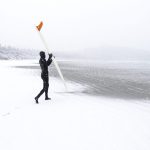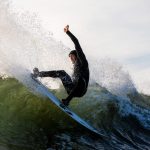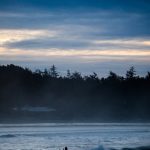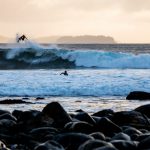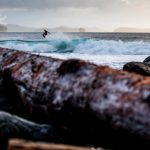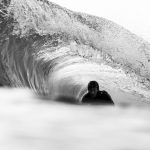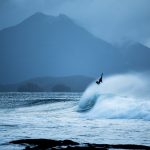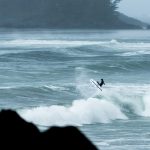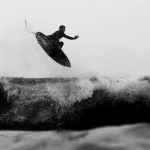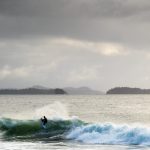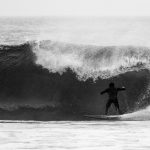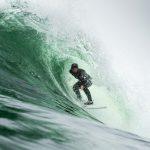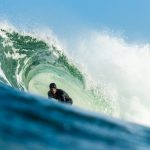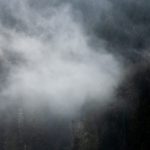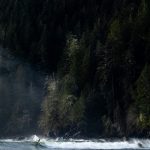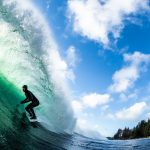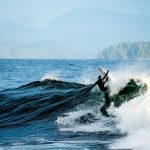He lives in Tofino on Vancouver Island’s west coast, an area known for its wild natural scenery of lakes, inlets, ancient rainforest and sandy beaches. Air temps are cool by Australian standards ranging from 8 to 19 degrees with the water markedly chillier. In Summer temps only get as high as 13 degrees and winter can get as low as 6 or 7 degrees. It is here that Marcus Paladino has carved a niche for himself as the Cold Water Surf Photographer Guy.
Many dream of surfing the waves of Hawaii, the Mentawai islands or G-Land, but for me, one of the top 3 spots on my bucket list is Tofino. To me there is just something so appealing about cold water and rugged alpine scenery. The chance to surf when it’s snowing in my book would be altogether something else. And so, I have been completely absorbed in the photography of Marcus Paladino. For so long I have been keen to chat with him and feature his work in Smorgasboarder and thankfully that opportunity finally came around. Marcus filled me in on how he earned his unofficial moniker what it’s like to be a surf photographer in these parts.
“I was very adamant on traveling for a really long time, like I would jump on any trip I could. I just wanted to see as much of the world as I could through surfing and through my camera. And then COVID happened and no one was traveling, and I was kind of, ok this will be a nice break from trying to go here and go there. And it just so happened we ended up having one of the best winters we’ve ever had here, and it was very productive. We got lots of waves and I got great photos and I suppose I didn’t realise how special this place is. I don’t need to spend two grand on a plane ticket to shoot something incredible. So, I kind of started putting more focus on just shooting here. So yeah, I now get really stoked on just shooting here and I feel like I’ve sort of unintentionally carved out this niche of being the cold water Canada surf photographer guy.
“I always sort of pictured that if you wanted to be a famous international surf photographer, you had to go all over the world. But I really enjoy my home and I’m very grateful to be here.”
As for how harsh conditions can sometimes be shooting in these parts, Marcus recalled a particular moment early on in his surf photography career.
“I have definitely pushed it and been out too long. My best story of that is blacking out from the cold. I was out for about three to four hours mid-winter and yeah, at one point I had to go in because I couldn’t move my hands to even push the trigger to take a picture. I got to the beach and then I don’t really remember what happened after that. I was just sitting there, and I had all my stuff around me.
“I haven’t done that since. I am definitely a bit more conscious. I think that was probably my second winter shooting here full time and I was a bit more like, I have to get the shot, I have to do this because if I don’t get the shot, someone else might. So, I was a bit more gung-ho then, whereas now I’m a bit more strategic.”
When you hear stories like this it is unbelievable to consider that Marcus’s home breaks aren’t even the coldest conditions he has encountered.
“It’s not so bad here. It’s obviously cold on the face, but the coldest place I ever felt was in Nova Scotia, which is on the east coast of Canada. We did a trip out there and every single time I went under a wave, it felt like I was getting tattoos on my face, it was so cold. That was probably the coldest water I’ve ever swam in.”
With that kind of commitment, Marcus’s unofficial moniker as “the cold water surf photographer guy” is well earnt and it is this kind of dedication to his craft that has seen his work published over the world in everything from surf magazines to adventure and geographic publications to advertising campaigns to promotional campaigns for various Canadian tourism bodies as well as CBC Sports and Netflix to name but a few of the myriad of clients.
“Thankfully I have established sort of a brand and these companies know who I am. So, I am definitely getting more people reaching out to me for things, which is amazing. But I do feel like I’m still sort of on that like grind where I know I’m shooting a lot, so I just want to make sure I can get my work out there.”
I was interested to ask Marcus whether he focused on a particular aspect of the surfer on the wave when he is shooting. For me, I absolutely love the way he captures a moment in time, with not only the surfer on a wave, but the wild wilderness surrounds. His photography takes you on an adventure and it is absolutely breathtaking.
With that said, when researching Marcus for this interview, I was interested to read an article about him in Wavelength magazine. I was quite surprised by the journalist’s perspective on cold water photography which went as follows, “too often with cold water destinations, photos need to depend on the mountains, snow and wildlife as a backdrop to make them work.”
Everyone is certainly entitled to their opinion, but I was just so blown away by the statement because to me personally, that is what makes many of Marcus’s photos so stunning. Hence, I was keen to hear his opinion on the topic.
“I try not to think too much when I’m shooting. For me, I’m a really big surf fan and my first gravitation is, I want to shoot really tight, I want to see the spray, I want to see the body positioning. But then as soon as I start doing that and I get a shot or two, I realise, ok, maybe I need to pull back now and see what the lighting is doing? And then I start pulling back a bit more and then as soon as I’ve got my tight shots that’s when I feel like I’ve covered my bases and now I can get creative, and I’ll start mixing it up and trying weird angles. And when you do that, you sort of like end up missing shots. But if you can nail one, it’s just so gratifying.
“You can become a bit numbed by this place, by its beauty in that way. I see the same backdrops and I see the same trees. I think when I’m shooting, I sometimes just sort of catch myself and be like, wait, this is an interesting shot. You know, even to me it’s interesting, but to other people, it’s like mind blowing in a way which is cool.”
Hearing of Marcus bobbing around in the turbulent, black, cold water for hours on end saw my mind drifting to what else he may have to contend with – strong tides, logs, orcas, white pointers? I couldn’t help but ask the question – regular readers know of my obsession.
“What’s interesting is we’ve never had any sort of shark sightings or shark attacks. I’m not sure if it’s because the water is too cold, or they don’t have anything to eat. I have heard that the orcas keep them at bay.
“That’s something I’m super grateful for. I never have to think about it surfing or shooting around here.
Having travelled around the more southern parts of the West Coast of New Zealand’s South Island where I witnessed so much debris, namely large logs in the line-up, I was interested to know if this posed any concerns. I mean, if you’re surfing solo and encounter a large log paddling out, it’s good night.
“If there was a really big storm, it’ll push in a lot of logs in. That doesn’t happen too often though, maybe a couple of times a year. But yeah, it’s a bit sketchy because we have to wait for the logs to push themselves into the shore but some guys will just go out and try to avoid them. It’s psycho.”
With all this nature going on I figured the benefit of surfing this region would be that you at least wouldn’t have to contend with large crowds in the water. I was misinformed.
“Well, you’d actually be really surprised. Surfing is so popular in Canada right now. I think with surfing being in the Olympics and stuff and COVID as well, just in Tofino alone there would be 50 people on one peak on some days if it’s good. Even in the winter, if it’s really good, there could be like 20, 30 people on it. That being said, you can still get a wave to yourself because there’s so many little nooks and crannies that if you don’t want to surf the popular spots, you can go on a little mission, go for a drive, go for a hike, and you can surf by yourself any day of the week. It’s just a matter if you want to put in that effort.
Speaking of the town, I was keen to hear more about Tofino.
“I didn’t start surfing until I was about 20. That’s when I moved to Tofino. It’s just a really cool town. And yeah, I moved out here with no intention of becoming a surf photographer. I was actually adamant on trying to be a snowboard photographer. Obviously in summer there’s nothing because you can’t really go snowboarding unless you’re on the glacier of Whistler. So, I moved out here to have a fun during summer and basically kill time until the next snowboard season. But then I fell in love with surfing and I fell in love with the town and the photography came out of that. So, I just started shooting my friends surfing and stuff and the end of summer came, and I never left.”
The relaxed seaside town of Tofino lies 200km north-west of the island’s largest city, Victoria, which incidentally is the capital of British Columbia. By road it is around 316 kms and a 5 hour drive from Victoria, but with so many interesting places to see and scenery to take in along the way, you will want to make this a multiday trip.
On the surfing side of things, as we mentioned previously, the water is on the chilly side and as Marcus informed us, everyone is pretty stoked in the summer months when they get to surf without gloves.
There are fun waves at the beach breaks during these months but the swell can tend be wind affected. September through to February are the prime months for surfing if you can handle the cold and own a quality wetsuit.
“It’s such a unique place, considering most of Canada’s coastline is quite rocky and abrasive and uninhabitable, whereas Tofino is situated so perfectly, and we have these perfect sand bottom beaches. It’s a really unique area.”
Now that travel has opened up again, I enquired whether Marcus had plans to venture further afield now that he could.
“Not at the moment. I definitely have a few ideas I want to do. I was thinking about maybe going to Scotland in the fall and New Zealand next summer but for now those are all just ideas.
For those interested Marcus recently published a 320-page portfolio of some of his greatest work. The hardcover titled ‘Cold Comfort’, for mine is nothing short of complete wonderment. I naturally asked whether he had plans for another.
“Right now, I’m still riding the high from this one. It’s been a great success and it’s been really cool to hear all the feedback. People really seem to enjoy it. Everyone’s asking when are you going to make another book? And I’m like, well, this one was hard enough to make. But yeah, I definitely want to make another book one day. I’ll approach the publishing company again in a few years and see if they want to do something else. But for now, I think I’m just riding the high of my first published book.”
